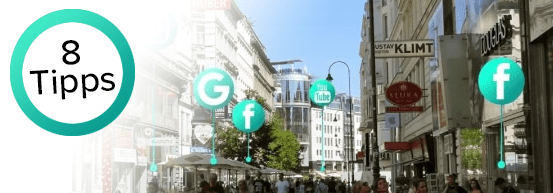
8 tips for local online marketing that always work
1. A dedicated website for each location
Especially as a chain store or retailer with multiple locations, each location should have its own web presence. In addition to the basic information, such as address, opening hours, services, images, route planner … store-specific content should also be displayed on the location webpage. Numerous tools offer simple administration services to create and manage even several 1,000 location pages quickly and easily.
Time and again, we see uninspired “location business cards” with outdated data that have to be laboriously accessed via location finders and offer little added value for users and customers. The specific location website is accordingly a good first start for local online marketing.
2. The Google business profile is sufficient to start
According to the principle of “with 20% effort I achieve 80% of the result”, this also applies to online directory listings. With over 95% usage rate in Germany, just start with the “Google business profile” to display the essential location information on Google and Google Maps. With a corresponding Google master account, these information can also be managed quite well there across all locations. With a large number of sites, directory listing management tools can help.
In the Google business profile, you can also add the specific location websites from point 1. In the end Google is often the better and more used location search than the one on your own website.
3. Keep an eye on your location ratings
With or without self-maintained location entries on Google and the like, users will begin to rateyour stores and locations on the web. Whether positive or negative, it is recommended to moderate and respond to these ratings in both cases. With many sites, this quickly becomes time-consuming; appropriate tools can help, which also inform you via alert when new evaluations are added.
4. Do not forget: User Tracking
Actually self-evident but nevertheless often forgotten or not consistently implemented: User tracking should also be built in on all possible local online touchpoints, especially also on the location weppages. Ideally, the user will find out about local offers and promotions on the location website and will then also use other services such as making an appointment, use the online shop and so on. Evaluating where users are coming from and how they behave can yield different results locally than nationally, helping to further optimize UX design, user flow, and overall local online marketing.
Important: Do not forget the call tracking! A large proportion of local customers communicate by telephone, especially in the case of service providers. Noticeable placed and tracked phone numbers per location can work wonders to generate further business and drive your own marketing campaigns.
5. Omnichannel offerings also for and in combination with the locations
Once you have your own online shop and have set up and maintained the location pages, it is advisable to also include products from the online shop on these location pages. Customers can buy simple products and offers directly online and use theservice in the store for more detailed advice.
The interaction of these product offerings and prices across online and offline channels naturally requires some effort, but the retailers that offer omnichannel will see the highest growth rates in the future, according to unanimous studies.
6. Local online campaigns for more customer frequency
In addition to optimizing the local SEO keywords on the location websites and setting up the online directory listings, it is also recommended to run a simple, permanent local online marketing campaignvia Google Ads for each location. At the beginning it is sufficient to advertise the location and their services as a “local provider” with the essential brand and product/service keywords. Small budgets starting at €100 per month are already sufficient here.
The advantage: Users can find online the offer at your location all year round. Due to the regional relevance, Google ranks local ads higher than national campaigns, which is reflected in lower CPCs and better ad positioning. At the same time, the locations are particularly highlighted in the Google Maps search and are displayed first in the search results for the keywords. This is an important competitive advantage, especially in the case of highly competitive offerings.
To avoid the problem of “duplicate content”, location page content and ads should be specific to the location, e.g. with local address, location naming and local services, and the location pages should be clearly marked as such.
Since the creation and management of numerous local online ad campaigns can become very time-consuming when there are multiple locations, we recommend the appropriate use of tools for the automation and control of local online marketing.
7. Local social-media campaigns
Local social media campaigns, depending on the target group via Facebook, Instagram, Tiktok and Co., can generate new customer contacts very quickly, especially with social media location pages. At the same time these campaigns generate social interaction with users.
Important: a local approach using text, images and video. In principle, the national brand should also have a local significance and likewise be cultivated locally. Regular local online campaigns then benefit both the brand and (local) sales.
8. One step after the other
If little time has been invested in the local online presence and local online marketing so far, one should not try to start too many activities at once. Local web presence and content are a good first step, but again, the 20/80 principle applies. Start first and expand later. You also don’t have to wait until all web touchpoints are perfectly created to start local online advertising efforts. A good Instagram ad or local Google SEA campaign already leads to more customer traffic via phone contacts and the like. By testing, adjusting and optimizing, the results can then be improved further and further. Here, too, campaign tracking is helpful and should be integrated from the very beginning.



